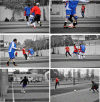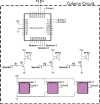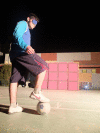Design and evaluation of sound-based electronic football soccer training system for visually impaired athletes
- PMID: 31234912
- PMCID: PMC6591927
- DOI: 10.1186/s12938-019-0695-5
Design and evaluation of sound-based electronic football soccer training system for visually impaired athletes
Abstract
Background: Several countries encourage the practice of football for rehabilitation and social inclusion purposes. For visually impaired people, football is purely sound-based, where the ball and the players are constantly emitting sounds for localization purposes in the field. However, the task of shooting the ball requires of a non-visually impaired extra person, behind the goal (known as caller), whom is punching the four corner of such goal to help the athletes. The presence of the caller restricts the self-sufficiency of the players. This work addresses such problem, by presenting a goal for visually impaired players with the aim of enhancing their self-sufficiency.
Materials and methods: The electronic goal is designed with four functionalities for training purposes, by returning sound-based feedback of its position and the places where the ball has impacted. The system is validated with seven volunteers from Chilean Football Soccer National Team. A questionnaire was answered by the players before and after the tests to statically validate the proposed device.
Results: The presented system is portable and designed following a modular criterion suitable for visually impaired people self-assembling. From a test of 350 shootings, the electronic goal showed to enhance the shooting assertiveness from 82 to 92%, and the accuracy from 20 to 56% compared to the traditional caller.
Conclusions: The electronic goal showed to enhance the self-sufficiency of athletes, by improving their assertiveness in shooting training. Nevertheless, and according to the responses to the questionnaires, the system needs improvements in its portability and handling.
Keywords: Echo-localization; Sports rehabilitation; Visually impaired people.
Conflict of interest statement
The authors declare that they have no competing interests.
Figures















References
-
- The Central Council of Physical Recreation (UK). Everybody wins: sports and social inclusion (2002). www.efds.co.uk/assets/0000/1696/OOO27.pdf.
-
- Xiao J, Joseph SL, Zhang X, Li B, Li X, Zhang J. An assistive navigation framework for the visually impaired. IEEE Trans Hum Mach Syst. 2015;45(5):635–640. doi: 10.1109/THMS.2014.2382570. - DOI
-
- The United Nations. Sports and persons with disabilities, Chapter 5 (2002). www.un.org/wcm/webdav/site/sport/shared/sport.
-
- Potter JCD. The contribution of sport and physical activity to the well-being of visually impaired people. Sci Sports. 2006;21:249–250. doi: 10.1016/j.scispo.2006.07.007. - DOI
-
- World Health Organization. www.who.int. Accessed June 2019.
Publication types
MeSH terms
Grants and funding
LinkOut - more resources
Full Text Sources
Medical

